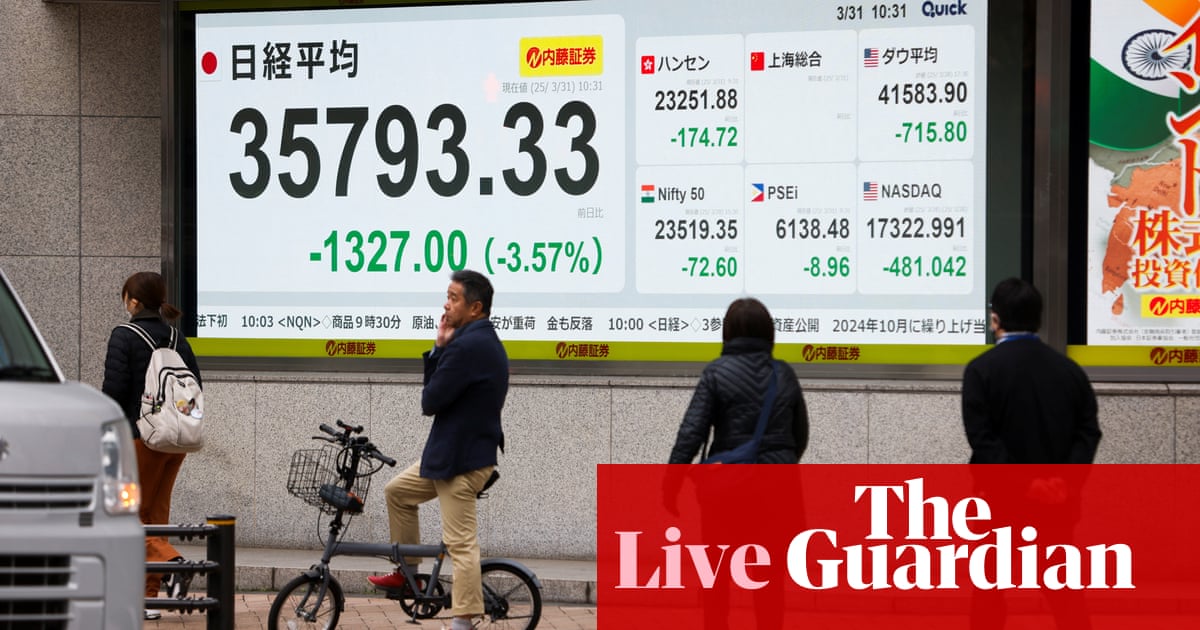
World markets and US dollar suffer worst monthly losses since 2022 as Trump trade war riles investors – business live
Introduction: World markets on track for biggest monthly loss since 2022
Good morning, and welcome to our rolling coverage of business, the financial markets and the world economy.
Donald Trump’s trade war is alarming the global markets, sending shares sliding in their worst month in over two years.
Stock markets across the Asia-Pacific region are in retreat this morning, as investors fear Trump will announce swingeing new tariffs on Wednesday, which has been dubbed “Liberation Day” by the US president.
Japan’s Nikkei has lost 3.9%, down 1,457 points at 35,662 points today, while South Korea’s KOSPI is down 3%, Australia’s S&P/ASX 200 has fallen 1.7%. In China, which has already been hit by Trump tariffs this year. the CSI 300 is 0.9% lower.
These are just the latest losses in a bad month for the financial markets. MSCI’s index of global stocks had fallen around 4.5% since the start of March, even before today is priced in, which would be the worst month since September 2022.
Today’s selloff comes after Donald Trump told reporters that the reciprocal tariffs he is set to announce this week will include all nations.
He told reporters on Air Force One:
“You’d start with all countries. Essentially all of the countries that we’re talking about.”
That is a blow to hopes that the White House might only target countries with the largest trade imbalances against the US.
Investors have also been spooked by recent bad economic news from the US.
On Friday, core inflation rose by more than expected, while consumer sentiment weakened to its lowest level since 2022. That drove shares down on Wall Street on Friday, and captured the fears in the markets right now.
Kyle Rodda, senior financial market analyst at capital.com, explains:
The dynamic is a microcosm of the essential fear in the market right now. Trade policy and even merely the uncertainty generated by it is weakening growth but also contributing to sticky inflation, meaning the Fed is going to have marginally less capacity to cut interest rates if (or when) US economic activity starts to falter.
The problem was hammered home further by a revised University of Michigan Consumer Sentiment survey which revealed even higher 1-year inflation expectations of 5% and a greater deterioration in confidence.
The agenda
-
9.30am BST: Bank of England mortgage approvals and consumer credit
-
1pm BST: German inflation rate for March
-
3.30pm BST: Dallas Fed Manufacturing Index for March
Key events
Gold hits another record high
The gold price has hit a new all-time high today, as Donald Trump’s threat of imposing reciprocal tariffs on all countries sparks a rush into save-haven assets.
Gold is up 1% today at $3,116 per ounce, having earlier traded as high as $3,128/oz, adding to its strong gains already this year.
KCM Trade chief market analyst Tim Waterer says:
“Markets’ anxiety levels have been ramping up ahead of the reciprocal U.S. tariff announcements, which is keeping gold in high demand as a defensive play.
“If the tariff announcements this week are not as severe as feared, then the gold price could start to backtrack as profit-taking from the highs may be triggered.”
Gold has gained around 9% during March, which Reuters has calculated would be its best month in a year.
Dollar index on track for worst month since November 2022
March has also been a grim month for the US dollar.
By my calculations, the dollar is on track for its largest monthly fall against a basket of major currencies since November 2022.
The dollar index has lost around 3.5% so far this month, as anxiety over looming tariffs against America’s trading partners.
New tariffs are likely to disrupt global trade, especially if other countries retaliate against Washington.
But the economic worries run deeper, as Stephen Innes, managing partner at SPI Asset Management, explains:
This isn’t just about trade—it’s about consumer behaviour, capex hesitation, and inflation stickiness all colliding at once.
So far this month, the pound has gained 3% against the dollar to $1.2760.
The euro is up 4.4% against the dollar, to $1.083.
Ipek Ozkardeskaya, senior analyst at Swissquote Bank, says:
In summary, the euro is looking stronger than sterling and the dollar, while the US dollar has become the weakest link among the three.
Introduction: World markets on track for biggest monthly loss since 2022
Good morning, and welcome to our rolling coverage of business, the financial markets and the world economy.
Donald Trump’s trade war is alarming the global markets, sending shares sliding in their worst month in over two years.
Stock markets across the Asia-Pacific region are in retreat this morning, as investors fear Trump will announce swingeing new tariffs on Wednesday, which has been dubbed “Liberation Day” by the US president.
Japan’s Nikkei has lost 3.9%, down 1,457 points at 35,662 points today, while South Korea’s KOSPI is down 3%, Australia’s S&P/ASX 200 has fallen 1.7%. In China, which has already been hit by Trump tariffs this year. the CSI 300 is 0.9% lower.
These are just the latest losses in a bad month for the financial markets. MSCI’s index of global stocks had fallen around 4.5% since the start of March, even before today is priced in, which would be the worst month since September 2022.
Today’s selloff comes after Donald Trump told reporters that the reciprocal tariffs he is set to announce this week will include all nations.
He told reporters on Air Force One:
“You’d start with all countries. Essentially all of the countries that we’re talking about.”
That is a blow to hopes that the White House might only target countries with the largest trade imbalances against the US.
Investors have also been spooked by recent bad economic news from the US.
On Friday, core inflation rose by more than expected, while consumer sentiment weakened to its lowest level since 2022. That drove shares down on Wall Street on Friday, and captured the fears in the markets right now.
Kyle Rodda, senior financial market analyst at capital.com, explains:
The dynamic is a microcosm of the essential fear in the market right now. Trade policy and even merely the uncertainty generated by it is weakening growth but also contributing to sticky inflation, meaning the Fed is going to have marginally less capacity to cut interest rates if (or when) US economic activity starts to falter.
The problem was hammered home further by a revised University of Michigan Consumer Sentiment survey which revealed even higher 1-year inflation expectations of 5% and a greater deterioration in confidence.
The agenda
-
9.30am BST: Bank of England mortgage approvals and consumer credit
-
1pm BST: German inflation rate for March
-
3.30pm BST: Dallas Fed Manufacturing Index for March










